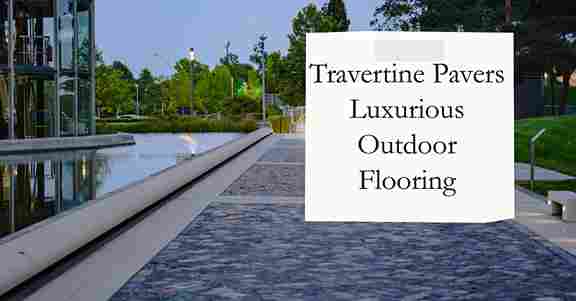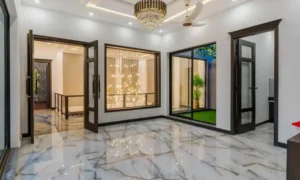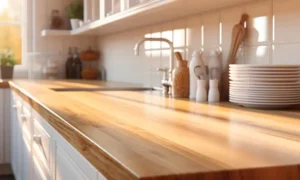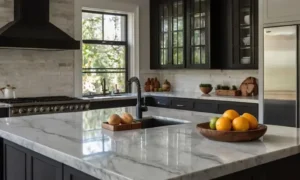Travertine Pavers: A Timeless Elegance for Your Outdoor Spaces
When it comes to enhancing the outdoor beauty of your home, travertine pavers stand out as an elegant and timeless choice. Their natural beauty and durability make them a popular option for various outdoor applications, including pool decks, patios, walkways, and driveways. In this article, we will explore the world of travertine pavers, covering their benefits, installation, maintenance, and more.
When it comes to high-quality outdoor flooring, nothing beats the elegance and durability of Travertine Pavers. At Sf Marble and Granite Inc, we offer an extensive collection of Travertine Pavers that are sure to enhance the beauty and functionality of your outdoor spaces.

What Are Travertine Pavers?
Travertine pavers are natural stones that originate from limestone deposits. These pavers feature unique patterns and earthy colors that add a touch of sophistication to any outdoor space. Their porous nature allows them to stay cool under the sun, making them an excellent choice for pool decks.
The Advantages of Using Travertine Pavers
Using travertine pavers offers several advantages, such as:
- Aesthetics: With a wide range of colors and patterns, travertine pavers can complement any outdoor design scheme.
- Durability: Travertine is a robust material that can withstand heavy foot traffic and weather conditions.
- Non-Slip Surface: The natural texture of travertine provides a non-slip surface, making it safe for pool areas.
- Heat Resistance: Travertine’s ability to stay cool makes it ideal for outdoor spaces in hot climates.
Factors to Consider Before Choosing Travertine Pavers
Before selecting travertine pavers, consider the following factors:
- Grade: Travertine pavers come in different grades, with premium grade offering fewer imperfections and a more uniform appearance.
- Finish: Choose from various finishes like tumbled, honed, or brushed, depending on your desired look.
- Thickness: The thickness of the pavers will depend on the application and the weight they need to bear.
- Sealing: Consider sealing the pavers to protect them from stains and maintain their beauty.
How to Install Travertine Pavers
Installing travertine pavers requires careful planning and execution. Here’s a general guide to the installation process:
- Preparation: Prepare the base by leveling the ground and ensuring proper drainage.
- Laying the Pavers: Start from one corner and lay the pavers in the desired pattern, leaving space for jointing.
- Cutting: Use a wet saw to cut pavers to fit the edges and corners.
- Jointing: Fill the gaps between pavers with jointing sand.
- Sealing: Apply a suitable sealer to protect the pavers and enhance their color.
Maintaining Your Travertine Pavers
Maintaining your travertine pavers is essential to ensure they retain their natural beauty and longevity. With proper care and attention, you can enjoy the timeless elegance of your outdoor space for many years to come. Here are some detailed tips on how to maintain your travertine pavers:
Regular Cleaning
Regular cleaning is the first step in maintaining your travertine pavers. Sweep the surface regularly to remove loose debris, leaves, and dirt. This simple practice will prevent abrasive particles from scratching the pavers’ surface.
Avoid Harsh Chemicals
When cleaning your travertine pavers, it is crucial to use mild detergents and avoid harsh chemicals. Acidic or alkaline cleaners can damage the surface and cause etching or discoloration. Instead, opt for a pH-neutral cleaner specifically designed for natural stone.
Spill Clean-Up
In the event of spills, especially from acidic substances like wine, coffee, or citrus juices, it’s vital to clean them up promptly. Wipe the spill with a soft cloth and a mild detergent. Prolonged exposure to acidic substances can cause stains and harm the travertine.
Sealing
Applying a high-quality sealer is an integral part of maintaining travertine pavers. Sealing helps protect the stone from water absorption, stains, and discoloration. Depending on the traffic and weather conditions, it is recommended to reapply the sealer every few years.
Preventing Stains
Prevention is better than cure when it comes to stains on travertine pavers. Use coasters under planters and furniture to prevent rust stains. Additionally, place doormats at entry points to reduce the amount of dirt and debris tracked onto the pavers.
Pressure Washing
Periodically, you may want to give your travertine pavers a more thorough cleaning. Pressure washing can be an effective method, but it must be done carefully. Use a pressure washer with a low setting and hold it at a reasonable distance from the pavers to avoid causing damage.
Removing Tough Stains
For stubborn stains that may have developed over time, there are specific poultice powders available for natural stone. Follow the manufacturer’s instructions and test a small area before applying the poultice to the entire stained area.
Repairing Cracks and Chips
If you notice any cracks or chips in your travertine pavers, it is essential to address them promptly. Small cracks can be repaired using a stone repair epoxy, while larger damages may require professional intervention.
Winter Care
During colder months, it’s crucial to protect your travertine pavers from potential frost damage. Avoid using rock salt or ice melt products on the surface, as they can cause damage. Instead, use sand for traction and remove snow promptly to prevent water from seeping into the stone.
By following these maintenance tips, you can ensure that your travertine pavers remain a stunning focal point of your outdoor space, exuding timeless elegance and adding value to your property. Proper care will not only preserve their natural beauty but also extend their lifespan, making them a wise and worthwhile investment for years to come.
Enhancing the Aesthetics of Your Space with Travertine Pavers
Travertine pavers offer versatility in design. Consider these tips to enhance your outdoor space:
- Patterns: Create unique patterns like herringbone or basketweave for visual appeal.
- Borders: Use contrasting colors or sizes to create stunning borders.
- Accents: Add decorative accents using different colors of travertine to create focal points.
Popular Applications of Travertine Pavers
Travertine pavers can be used in various outdoor settings, including:
- Patios: Transform your patio into a luxurious retreat with travertine pavers.
- Walkways: Create inviting walkways with the beauty of travertine.
- Driveways: Make a statement with an elegant travertine driveway.
- Pool Decks: Experience the comfort and style of travertine around your pool.
Travertine Pavers vs. Other Types of Pavers
When it comes to selecting the right paving material for your outdoor space, there are various options available. Each type of paver has its unique characteristics and benefits. In this section, we will compare travertine pavers with other popular types of pavers, helping you make an informed decision based on your specific needs and preferences.
Travertine Pavers
Advantages:
- Timeless Elegance: Travertine pavers offer a classic and sophisticated look that adds a touch of luxury to any outdoor space.
- Natural Beauty: With a wide range of earthy colors and intricate patterns, each travertine paver is a unique work of art.
- Cool Surface: Travertine’s porous nature allows it to stay cool under the sun, making it perfect for pool decks and hot climates.
- Durability: These pavers can withstand heavy foot traffic and weather conditions, maintaining their integrity for years.
Considerations:
- Porous Surface: The porous nature of travertine can make it susceptible to stains if not properly sealed and maintained.
- Regular Sealing Required: To protect against stains and moisture, travertine pavers need periodic sealing.
Concrete Pavers
Advantages:
- Affordability: Concrete pavers are generally more budget-friendly compared to natural stone options.
- Versatility: They come in various shapes, sizes, and colors, allowing for creative design possibilities.
- Ease of Installation: Concrete pavers are uniform in size and shape, making them easy to install in different patterns.
Considerations:
- Appearance: While concrete pavers can mimic natural stone, they may not possess the same level of elegance and authenticity.
- Heat Absorption: Concrete pavers can retain heat, making them less suitable for areas where heat is a concern.
Brick Pavers
Advantages:
- Classic Charm: Brick pavers offer a timeless and rustic look that complements traditional and historical architecture.
- Durability: They are sturdy and can withstand heavy loads, making them suitable for driveways and high-traffic areas.
Considerations:
- Limited Color Options: Brick pavers typically come in shades of red and brown, limiting design possibilities.
- Susceptible to Weeds: The gaps between brick pavers can promote weed growth, requiring regular maintenance.
Cobblestone Pavers
Advantages:
- Old-World Aesthetics: Cobblestone pavers exude a vintage charm and create a sense of nostalgia.
- Natural and Irregular Shapes: Each cobblestone is unique, providing a rustic and authentic appearance.
Considerations:
- Uneven Surface: The irregular shapes of cobblestones can create an uneven surface, requiring careful installation and maintenance.
- Cost: Cobblestone pavers can be more expensive compared to other options due to their uniqueness and labor-intensive installation
Cost Considerations for Travertine Pavers
The cost of travertine pavers depends on various factors, including grade, size, finish, and location. While they may be more expensive than concrete pavers, their elegance and longevity make them a worthwhile investment.
When planning to install travertine pavers for your outdoor space, it is essential to understand the various cost considerations involved. While travertine pavers offer timeless elegance and durability, their pricing can vary based on several factors. By being aware of these considerations, you can make an informed decision that aligns with your budget and project requirements.
Installation Complexity
The complexity of the installation can affect the overall cost. If your project requires intricate patterns, designs, or cuts, it may require more labor and time, leading to higher installation costs.
Quantity Needed
The total number of travertine pavers required for your project will impact the overall cost. Accurately measuring the area and calculating the quantity needed will help you budget accordingly.
Supplier and Location
The supplier you choose and your geographical location can also influence the cost of travertine pavers. Some suppliers may offer competitive prices or discounts, while shipping costs can vary based on your location.
Maintenance and Long-Term Cost
While travertine pavers may have a higher upfront cost compared to some other materials, their durability and longevity can lead to cost savings in the long run. Properly maintained travertine pavers can last for decades, reducing the need for frequent replacements.
Finding the Right Travertine Pavers Near You
To find the right travertine pavers near you, consider visiting local stone yards, home improvement stores, or contacting reputable suppliers like SF Marble and Granite Inc.
When embarking on a project to enhance your outdoor space with travertine pavers, finding the right supplier or retailer is crucial. The quality of the materials, the variety of options available, and the level of customer service can significantly impact the success of your project. Here are some essential tips for finding the right travertine pavers near you:
Research Local Suppliers
Start by researching local suppliers or stone yards that specialize in natural stone products. Look for companies with a good reputation and positive customer reviews. You can also seek recommendations from friends, family, or professionals who have experience with travertine pavers.
Visit Showrooms
If possible, visit showrooms or stores in person to view the different travertine paver options they offer. Seeing the materials up close will allow you to assess the quality, colors, and finishes available. Additionally, knowledgeable staff can assist you in making the right choice for your project.
Check the Variety
Ensure that the supplier offers a wide variety of travertine pavers in different colors, sizes, finishes, and grades. Having a diverse selection will enable you to find the perfect pavers that match your design vision and suit your specific application needs.
Quality and Authenticity
Inspect the quality of the travertine pavers on offer. High-quality pavers will have uniform thickness, minimal imperfections, and consistent coloring. Authenticity is essential, as genuine natural stone will have unique patterns and textures.
Request Samples
Ask for samples of the travertine pavers you are interested in. This will allow you to take them home and see how they look in your outdoor space under different lighting conditions. Evaluating samples can help you make an informed decision.
Inquire About Services
Inquire about additional services the supplier may offer, such as delivery, installation, or maintenance. Some suppliers may provide installation guides or recommend professional contractors to ensure a successful installation.
Compare Prices
While price should not be the sole determining factor, it is essential to compare prices among different suppliers to ensure you are getting a fair deal. Be cautious of significantly lower prices, as they may indicate lower quality materials.
Ask about Warranty
Check if the supplier offers any warranties or guarantees on their travertine pavers. A reputable supplier will stand behind the quality of their products and provide appropriate warranties.
Consider Local Availability
Choosing a supplier located near you can help reduce shipping costs and expedite delivery. Local suppliers may also have a better understanding of your region’s climate and environmental factors.
Customer Reviews and References
Before making a final decision, read customer reviews and ask for references from previous customers. Hearing about others’ experiences with the supplier can give you valuable insights into their reliability and customer service.
The Perfect Pool Deck: Swimming Pool Travertine Pavers
Transform your pool area with swimming pool travertine pavers. Their non-slip surface, heat resistance, and elegant appearance make them an excellent choice for pool decks.
Discover the Brand: SF Marble and Granite Inc.
SF Marble and Granite Inc. is a trusted name in providing high-quality travertine pavers and other natural stones. With a wide selection and professional services like Granite installation Swimming pool tiles etc.They can help bring your outdoor vision to life.
Conclusion
Travertine pavers are an exquisite choice for enhancing the beauty and functionality of your outdoor spaces. With their durability, aesthetics, and versatility, they provide a timeless charm that complements any design style. Whether you’re looking to revamp your pool deck, create an inviting patio, or construct a captivating driveway, travertine pavers offer a seamless blend of elegance and practicality.
FAQs
Are travertine pavers slippery when wet?
While travertine pavers have a naturally non-slip surface, it’s essential to choose a suitable finish and ensure proper drainage to maintain their slip resistance.
Can I install travertine pavers myself?
Installing travertine pavers can be a DIY project, but it requires proper planning, tools, and expertise. It’s recommended to seek professional assistance for the best results.
How do I clean stains from travertine pavers?
For stains, use a mixture of water and a mild detergent. Avoid harsh chemicals that could damage the surface.
Do travertine pavers fade over time?
With proper maintenance and sealing, travertine pavers can retain their color and beauty for many years.
Can travertine pavers be used indoors?
Yes, travertine pavers can be used indoors for various applications like flooring and walls, adding a touch of natural elegance to interior spaces.
Contact Us



